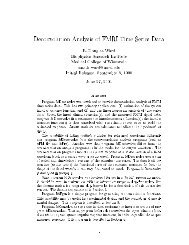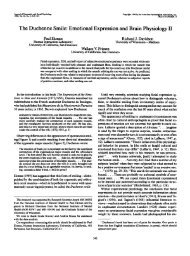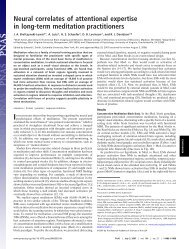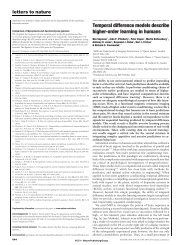l1-magic : Recovery of Sparse Signals via Convex Programming
l1-magic : Recovery of Sparse Signals via Convex Programming
l1-magic : Recovery of Sparse Signals via Convex Programming
Create successful ePaper yourself
Turn your PDF publications into a flip-book with our unique Google optimized e-Paper software.
We add the ’Optimization’ directory (where the interior point solvers reside) and the ’Data’<br />
directories to the path. The file RandomStates.m contains two variables: rand state and<br />
randn state, which we use to set the states <strong>of</strong> the random number generators on the next<br />
two lines (we want this to be a “repeatable experiment”). The next few lines set up the problem:<br />
a length 512 signal that contains 20 spikes is created by choosing 20 locations at random<br />
and then putting ±1 at these locations. The original signal is shown in Figure 1(a). The next<br />
few lines:<br />
% measurement matrix<br />
disp(’Creating measurment matrix...’);<br />
A = randn(K,N);<br />
A = orth(A’)’;<br />
disp(’Done.’);<br />
% observations<br />
y = A*x;<br />
% initial guess = min energy<br />
x0 = A’*y;<br />
create a measurement ensemble by first creating a K × N matrix with iid Gaussian entries,<br />
and then orthogonalizing the rows. The measurements y are taken, and the “minimum energy”<br />
solution x0 is calculated (x0, which is shown in Figure 1 is the vector in {x : Ax = y} that is<br />
closest to the origin). Finally, we recover the signal with:<br />
% solve the LP<br />
tic<br />
xp = <strong>l1</strong>eq_pd(x0, A, [], y, 1e-3);<br />
toc<br />
The function <strong>l1</strong>eq pd.m (found in the ’Optimization’ subdirectory) implements the primal-dual<br />
algorithm presented in Section 2.1; we are sending it our initial guess x0 for the solution, the<br />
measurement matrix (the third argument, which is used to specify the transpose <strong>of</strong> the measurement<br />
matrix, is unnecessary here — and hence left empty — since we are providing A explicitly),<br />
the measurements, and the precision to which we want the problem solved (<strong>l1</strong>eq pd will terminate<br />
when the surrogate duality gap is below 10 −3 ). Running the example file at the MATLAB<br />
prompt, we have the following output:<br />
>> <strong>l1</strong>eq_example<br />
Creating measurment matrix...<br />
Done.<br />
Iteration = 1, tau = 1.921e+02, Primal = 5.272e+01, PDGap = 5.329e+01, Dual res = 9.898e+00, Primal res = 1.466e-14<br />
H11p condition number = 1.122e-02<br />
Iteration = 2, tau = 3.311e+02, Primal = 4.383e+01, PDGap = 3.093e+01, Dual res = 5.009e+00, Primal res = 7.432e-15<br />
H11p condition number = 2.071e-02<br />
Iteration = 3, tau = 5.271e+02, Primal = 3.690e+01, PDGap = 1.943e+01, Dual res = 2.862e+00, Primal res = 1.820e-14<br />
H11p condition number = 2.574e-04<br />
Iteration = 4, tau = 7.488e+02, Primal = 3.272e+01, PDGap = 1.368e+01, Dual res = 1.902e+00, Primal res = 1.524e-14<br />
H11p condition number = 8.140e-05<br />
Iteration = 5, tau = 9.731e+02, Primal = 2.999e+01, PDGap = 1.052e+01, Dual res = 1.409e+00, Primal res = 1.380e-14<br />
H11p condition number = 5.671e-05<br />
Iteration = 6, tau = 1.965e+03, Primal = 2.509e+01, PDGap = 5.210e+00, Dual res = 6.020e-01, Primal res = 4.071e-14<br />
H11p condition number = 2.054e-05<br />
Iteration = 7, tau = 1.583e+04, Primal = 2.064e+01, PDGap = 6.467e-01, Dual res = 6.020e-03, Primal res = 3.126e-13<br />
H11p condition number = 1.333e-06<br />
Iteration = 8, tau = 1.450e+05, Primal = 2.007e+01, PDGap = 7.062e-02, Dual res = 6.020e-05, Primal res = 4.711e-13<br />
H11p condition number = 1.187e-07<br />
Iteration = 9, tau = 1.330e+06, Primal = 2.001e+01, PDGap = 7.697e-03, Dual res = 6.020e-07, Primal res = 2.907e-12<br />
H11p condition number = 3.130e-09<br />
Iteration = 10, tau = 1.220e+07, Primal = 2.000e+01, PDGap = 8.390e-04, Dual res = 6.020e-09, Primal res = 1.947e-11<br />
H11p condition number = 3.979e-11<br />
Elapsed time is 0.141270 seconds.<br />
The recovered signal xp is shown in Figure 1(c). The signal is recovered to fairly high accuracy:<br />
>> norm(xp-x)<br />
8




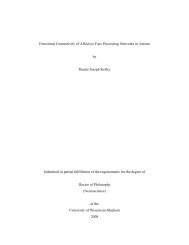
![[F-18]-L-DOPA PET scan shows loss of dopaminergic neurons](https://img.yumpu.com/41721684/1/190x146/f-18-l-dopa-pet-scan-shows-loss-of-dopaminergic-neurons.jpg?quality=85)
